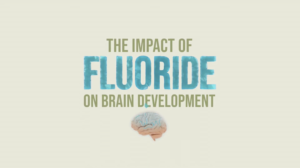The former director of the NIH National Institute of Environmental Health Sciences (NIEHS), Dr. Linda Birnbaum, and top scientists in researching fluoride neurotoxicity (Dr. Bruce Lanphear, Dr. Christine Till) have released an Important Op-ed highlighting mounting evidence that suggests fluoride may be hampering brain development and reducing kids’ IQ.
The Op-ed is accompanied by a powerful short video on the impact of fluoride on brain development. (video below)
“Over the past 75 years, health authorities have promoted community water fluoridation to reduce dental caries. Until recently, however, no studies had examined the safety of fluoride in vulnerable populations, like pregnant women and infants. This video describes the history of water fluoridation and new research that found fluoride is toxic to the developing brain.”
The video was produced by Little Things Matter, a non-profit scientific organization composed of children’s environmental health professionals.
Read how to reduce fluoride intake here.
Video Script with Hyperlinked References
For years, we were led to believe that fluoride is safe. (1,2)
(HODGE VIDEO) (3)
Is fluoride really safe?
Let’s look at what we’ve learned over the past century.
In the 1930s, a dentist discovered that children who drank water with naturally high levels of fluoride had fluorosis – the staining or mottling of teeth. (4)
Children with fluorosis had about 5 fewer cavities than children without fluorosis. (5)
Next, scientists showed that adding fluoride to drinking water led to less tooth decay. (5)
Unfortunately, tooth mottling increased as more fluoride was added to water. (5,6)
The optimal range or “sweet spot” to prevent tooth decay and minimize mottling was about 1 ppm. (5)
Meanwhile, the sugar industry, which knew sugar caused tooth decay, promoted the use of fluoride and mounted a campaign to thwart efforts to reduce sugar consumption. (7)
Then, beginning in the 1970s, soon after fluoride was added to toothpaste, cavities declined sharply in countries with water fluoridation. (8)
But they also declined in countries without fluoridation. (8)
Today, about 75% of Americans (9) and 38% of Canadians (10) drink fluoridated water. (These numbers are based on the American and Canadian population on community water systems)
A new study showed that water fluoridation prevents about one cavity per child. (11)
Still, over 90% of Americans have tooth decay. (12)
Meanwhile, scientists began to find clues that fluoride was toxic to the developing brain. (13,14,15)
Everybody agrees that fluoride is toxic at very high levels. (16)
What about lower levels?
In over a dozen studies – mostly from China – children who lived in villages with naturally high levels of fluoride had about 7 fewer IQ points than children in other villages. (15)
But those levels were somewhat higher than those found in North America.
Two newer studies of pregnant women and their children – one in Mexico (17), where fluoride is added to salt, and other one in Canada (18), where fluoride is added to water – also found that fluoride led to IQ deficits in children.
As fluoride levels increased in pregnant women from .1 ppm to 1 ppm, the IQ scores of their children dropped, by about 3 to 5 points. (17,18)
What about infants?
As fluoride increased in infants, their IQ scores dropped further, especially in formula-fed babies. (19)
Infants who are fed formula made with fluoridated tap water ingest more fluoride than a breasted infant; breastmilk contains low amounts of fluoride. (20,21,22,23,24,25)
Some critics say that because our study was an observational study – we didn’t dose pregnant women with fluoride, like a drug study – it was inconclusive. (26)
But if we dismissed all observational studies, we would have little evidence that water fluoridation prevents tooth decay. (27)
Some critics say it is only one study. (26,28)
But that ignores over a dozen high-quality studies showing that fluoride is toxic to the developing brain. (29,30)
Some critics say it is of little consequence if a child loses 3 to 5 IQ points. (26)
Is it worth losing 5 IQ points to prevent one cavity?
Let’s look at the impact of reducing children’s IQ score by 5 points.
Most of us have IQ scores that fall between 85 and 115 points. (31)
Only 2.5% of children have an IQ above 130, which is considered gifted. There are about 6 million children in this group. (32)
On the other end of the distribution, another 2.5% of children have an IQ below 70, which is considered “challenged.” (32)
A 5-point drop in IQ results in a 57% increase in the number of children that are challenged, from 6 million to 9.4 million.
There is a corresponding decrease in the number of children that are gifted, from 6 million to 2.4 million. (33)
What’s more, children are often to exposed to many chemicals that impair brain development – like lead, air pollution, pesticides and fluoride. The impact of 3 or 4 toxic chemicals adds up and greatly increases the number of children who are challenged. (34)
What can you do?
Pregnant women and infants should reduce fluoride intake. After all, it only benefits children once their teeth have erupted.(35)
If you are pregnant, don’t drink fluoridated water or black tea. (36) (Black teas have high concentrations of natural fluoride due to the accumulation of fluoride in tea leaves from the soil, Fung et al., 1999).
If possible, breastfeed your baby. (37,38)
Otherwise, don’t use fluoridated water to make infant formula. (19)
Children should only use a rice-sized amount of toothpaste when they brush their teeth, not the amount shown on toothpaste commercials and they shouldn’t swallow it. (39)
Adding fluoride to water isn’t the only way to prevent cavities.
You can choose not to buy products from companies that market sweetened drinks and highly processed foods to children. After all, sugar is the main cause of tooth decay. (7)

